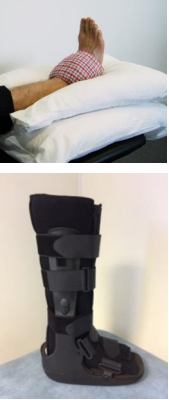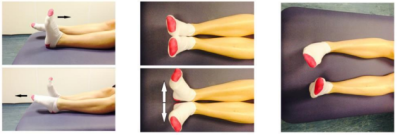This leaflet answers common questions about non-weight bearing midfoot fractures. If you would like further information, or have any worries, please do not hesitate to ask your nearest clinician.

What is a non-weight bearing midfoot fracture?
This is a break to a bone in the middle of your foot.
Healing
It normally takes six to 12 weeks for the fracture to heal; Smoking will slow down your healing. We would advise that you stop smoking while your fracture heals. Talk to your GP for more information.
Pain and swelling
Your ankle may be swollen and painful. Swelling is often worse at the end of the day. It is normal to have mild pain and swelling for three to six months after your injury. Taking pain medication, elevating your ankle and using ice or cold packs will help.
Wearing your boot
You are only allowed to touch your foot on the floor for balance. You should not put weight through your foot; it should rest lightly on the floor only. You will need crutches to help you walk. The boot protects your foot and will make you more comfortable. Wear the boot when you are standing and walking. You can take it off at night and at rest. You need to wear the boot for at least six weeks after your injury. Please inform us if you are diabetic; you may require a specialist boot.
Exercise and activity
It is important to start exercises as soon as possible. Instructions are further down this page.
Follow up
A follow-up appointment is not normally needed for this injury. If you still have significant pain and swelling after three months, then please contact the virtual fracture clinic team.

Caring for your injury: Weeks 1 to 2
Remember to wear your boot whenever standing and walking. You should only rest your foot on the floor lightly. You will need to walk like this for the first two weeks. You can remove the boot when resting and at night. Wear a long sock in your boot.
Using a cold pack will help with your pain and swelling. You can use an ice pack or bag of frozen peas wrapped in a damp towel. Put this on your ankle for 15 minutes every few hours. Make sure the ice isn’t in direct contact with your skin.
Try to rest your ankle, especially in the first 24-72 hours. Raise your ankle on a stool or cushions so that it is above the level of your hip. This will help to reduce your swelling.
Exercises
Early movement of the ankle and foot is important to promote circulation and reduce the risk of developing a Deep Vein Thrombosis (blood clot). Do these exercises three to four times a day. Start straight away, you do not need to push into pain.

- Point your foot up and down. Repeat this 10 times.
- With your heels together, move your toes apart to turn the foot outwards. Repeat this 10 times. Do this movement gently within comfort.
- Make gentle circles with your foot in one direction and then the other direction. Repeat this 10 times.
Caring for your injury: Weeks 2 to 6
It is now two weeks since your injury and you can start to put more weight through your foot. Keep using your boot when you are standing and walking.
By six weeks after your injury you should be able to put full weight through your foot. You can stop using your crutches as soon as you feel ready.
It is normal to still have mild discomfort and swelling. This may continue for three to six months. Keep elevating your leg and using ice packs.
Activity and exercise
Keep doing the exercises until you have full movement in the foot.
I am struggling with my boot. What do I do?
The boot has a thicker sole; this can make you feel uneven. Make sure you wear a supportive shoe or trainer on your uninjured foot. This will reduce stress on other joints. If you need more advice, contact the Virtual Fracture Clinic.
Watch this NHS video on fitting your boot
I am diabetic, does this change things?
If you are diabetic please contact us to discuss your boot. This is particularly important if you have problems with your skin or sensation. We may provide you with a specialist diabetic boot.
Driving
You can return to driving when:
- You are no longer using your boot,
- You can walk comfortably and
- You can perform an emergency stop pain free.
Always test your ability to drive in a safe environment first.
Fitness for work statement
You can get a fitness for work statement from your GP or the doctor at your Fracture Clinic appointment.
What do I do with my boot and crutches when I no longer need them?
We are not able to use boots again. These should not be returned to the hospital. Crutches can be returned to the fracture clinic or emergency department (A&E).
 Translate
Translate